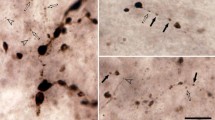Summary
-
1.
The femoral tactile spine of the cockroach is a mechanoreceptor with a single sensory neuron. The response to a step movement is a burst of action potentials which decays to zero in about 1 s. This rapid adaptation is a property of the action potential initiating region of the neuron.
-
2.
The oxidizing agents chloramine-T andN-chlorosuccinimide selectively and irreversibly remove sodium channel inactivation from neurons in several preparations and are believed to act by oxidation of methionine or cysteine residues in the proteins of the sodium channel.
-
3.
Chloramine-T andN-chlorosuccinimide, applied for a controlled time period, eliminated the rapid adaptation of the tactile spine neuron to an electrical depolarization. After treatment it fired tonically in response to a steady current stimulus. Longer applications of the agents eventually raised the threshold for action potential initiation.
-
4.
Threshold behavior in the tactile spine neuron was characterized by measuring strength-duration relationships for stimulation with extracellular current pulses at the action potential initiating region. The two oxidizing agents caused a voltage-dependent modification of the dynamic threshold properties which led to the change from rapidly adapting to tonic behavior.
-
5.
Two stronger oxidizing agents,N-bromoacetamide andN-bromosuccinimide, raised the threshold of the neuron without removing rapid adaptation. These two agents act similarly to chloramine-T andN-chlorosuccinimide on sodium inactivation in other neurons but are believed to oxidize the tryptophan, tyrosine and histidine residues of proteins in addition to cysteine and methionine.
-
6.
These results suggest that a form of sodium channel inactivation is responsible for rapid sensory adaptation in this neuron, but one which is different in time course and chemical sensitivity to the sodium inactivation seen in many other neurons.
Similar content being viewed by others
References
Armstrong CM, Bezanilla F, Rojas E (1973) Destruction of sodium conductance inactivation in squid axons perfused with pronase. J Gen Physiol 62:375–391
Bernard J, Guillet JC, Coillot JP (1980) Evidence for a barrier between blood and sensory terminal in an insect mechanoreceptor. Comp Biochem Physiol A 67:573–579
Bohnenberger J (1981) Matched transfer characteristics of single units in a compound slit sense organ. J Comp Physiol 142:391–402
Chapman KM, Smith RS (1963) A linear transfer function underlying impulse frequency modulation in a cockroach mechanoreceptor. Nature 197:699–700
Chesler M, Fourtner CR (1981) Mechanical properties of a slow muscle in the cockroach. J Neurobiol 12:391–402
French AS (1984a) Action potential adaptation in the femoral tactile spine of the cockroach,Periplaneta americana J Comp Physiol A 155:803–812
French AS (1984b) The receptor potential and adaptation in the cockroach tactile spine. J Neurosci 4:2063–2068
French AS (1985) After-hyperpolarization and receptor potential attenuation following bursts of action potentials in an insect mechanoreceptor. Can J Physiol Pharmacol 63:18–21
French AS (1986a) The role of calcium in the rapid adaptation of an insect mechanoreceptor. J Neurosci 6:2322–2326
French AS (1986b) Strength-duration properties of a rapidly adapting insect sensory neuron. J Comp Physiol A 159:757–764
French AS, Sanders EJ (1981) The mechanosensory apparatus of the femoral tactile spine of the cockroach,Periplaneta americana. Cell Tissue Res 219:53–68
Gestrelius S, Grampp W, Sjolin L (1981) Subthreshold and near threshold membrane currents in lobster stretch receptor neurones. J Physiol 310:191–203
Hille B (1984) Ionic channels of excitable membranes. Sinauer Associates, Sunderland, Massachusetts
Hodgkin AL, Huxley AF (1952) A quantitative description of membrane current and its application to conduction and excitation in nerve. J Physiol 117:500–544
Jack JJB, Noble D, Tsien RW (1983) Electric current flow in excitable cells. Oxford University Press
Lapique L (1907) Recherches quantitatifs sur l'excitation électrique des nerfs traitée comme une polarisation. J Physiol (Paris) 9:622–635
Nakajima S, Onodera K (1969) Membrane properties of the stretch receptor neurones of crayfish with particular reference to mechanisms of sensory adaptation. J Physiol 200:161–185
Noda M, Shimizu S, Tanabe T, Takai T, Kayano T, Ikeda T, Takahashi H, Nakayama H, Kanaoka Y, Minamino N, Kangawa K, Matsuo H, Raftery MA, Hirose T, Inayama S, Hayashida H, Miyata T, Numa S (1984) Primary structure ofElectrophorus electricus sodium channel deduced from cDNA sequence. Nature 312:121–127
Ottoson D, Swerup C (1985a) Ionic dependence of early adaptation in the crustacean stretch receptor. Brain Res 336:1–8
Ottoson D, Swerup C (1985b) Effects of intracellular TEA injection on early adaptation of crustacean stretch receptor. Brain Res 336:9–17
Oxford GS, Wu CH, Narahashi T (1978) Removal of sodium channel inactivation in squid giant axons by N-bromoacetamide. J Gen Physiol 71:227–247
Patlak J, Horn R (1982) Effect ofN-Bromoacetamide on single sodium channel currents in excised membrane patches. J Gen Physiol 79:333–351
Salgado VL, Yeh JZ, Narahashi T (1985) Voltage-dependent removal of sodium inactivation byN-bromoacetamide and pronase. Biophys J 47:567–571
Salkoff L, Butler A, Hiken M, Wei A, Giffen K, Ifune C, Mandel G (1986) ADrosophila gene with homology to the vertebrate sodium channel. Soc Neurosci Abstr 12:410.9
Schechter Y, Burnstein Y, Patchornik A (1975) Selective oxidation of methionine residues in proteins. Biochemistry 14:4497–4503
Sokolove PG, Cooke IM (1971) Inhibition of impulse activity in a sensory neuron by an electrogenic pump. J Gen Physiol 57:125–163
Vallbo AB (1964) Accommodation related to inactivation of the sodium permeability in single myelinated nerve fibres fromXenopus laevis. Acta Physiol Scand 61:429–444
Wang GK (1984a) Modification of sodium channel inactivation in single myelinated nerve fibres by methionine-reactive chemicals. Biophys J 46:121–124
Wang GK (1984b) Irreversible modification of sodium channel inactivation in toad myelinated nerve fibres by the oxidant chloramine-T. J Physiol 346:127–141
Wang GK, Brodwick MS, Eaton DC (1985) Removal of sodium channel inactivation in squid axon by the oxidant chloramine-T. J Gen Physiol 86:289–302
Author information
Authors and Affiliations
Rights and permissions
About this article
Cite this article
French, A.S. Removal of rapid sensory adaptation from an insect mechanoreceptor neuron by oxidizing agents which affect sodium channel inactivation. J. Comp. Physiol. 161, 275–282 (1987). https://doi.org/10.1007/BF00615247
Accepted:
Issue Date:
DOI: https://doi.org/10.1007/BF00615247




